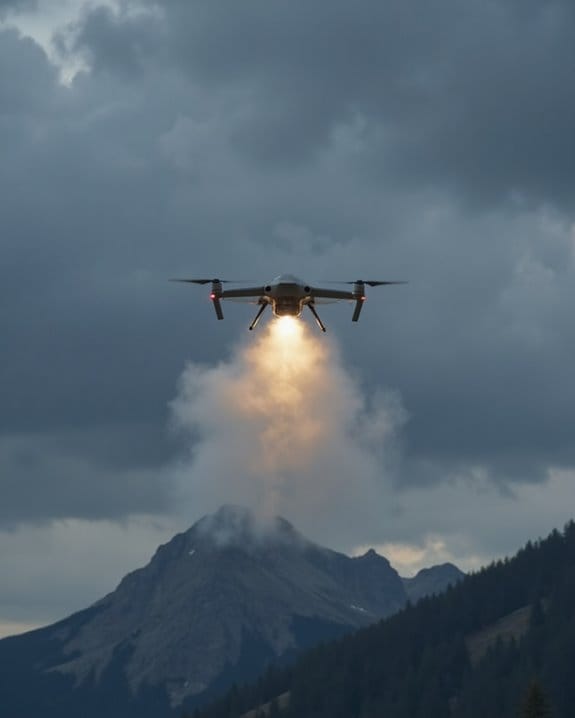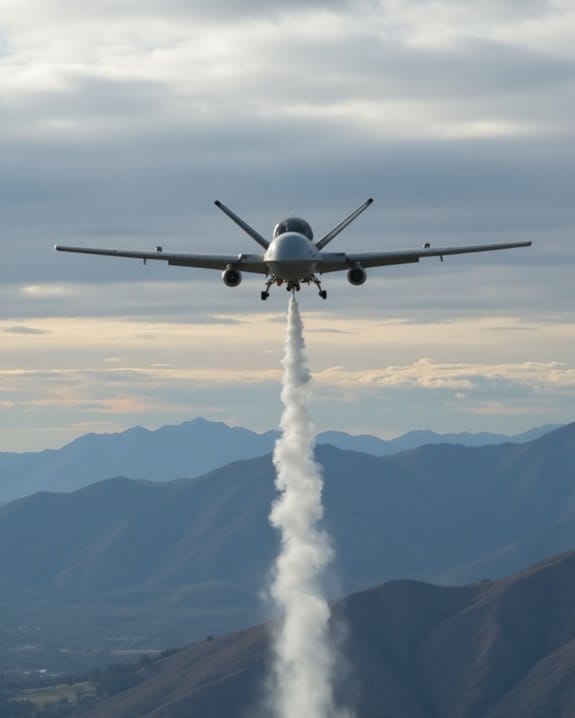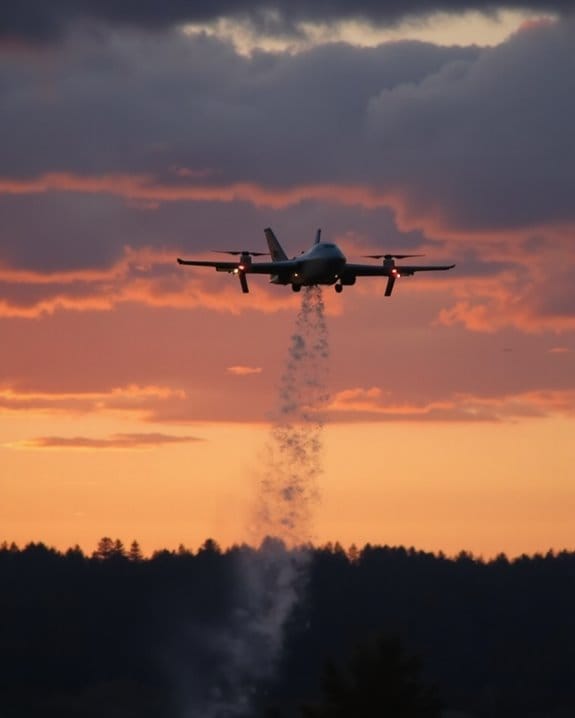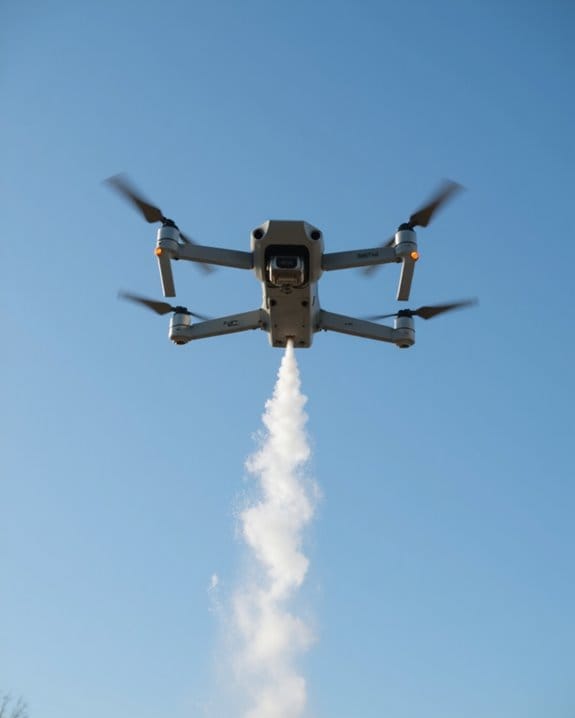You won’t see drones dumping fuel during flight because, unlike big passenger jets, most drones—including military types like the MQ-9 Reaper—aren’t equipped with fuel jettison systems. Drones are engineered for efficiency and endurance, carrying only the fuel they need, so weight management via dumping never enters the equation. If you’re picturing a drone leaving a vapor trail, that’s not fuel but probably a shadow of Hollywood imagination. Curious how full-size jets handle fuel in emergencies? Let’s break that down next.
Key Takeaways
- Most drones, including military and commercial models, do not have fuel dumping systems and cannot jettison fuel during flight.
- Drones are typically designed for efficiency and endurance, minimizing excess fuel and eliminating the need for dumping hardware.
- Fuel dumping is a safety feature found on large manned aircraft to quickly reduce landing weight, not on drones.
- The 2023 Su-27 incident involved a manned jet dumping fuel onto a drone, not the drone dumping its own fuel.
- Drone operators manage weight and fuel efficiency through careful planning, not by dumping fuel during missions.
Understanding Maximum Takeoff and Landing Weights
Ever wondered why aircraft can take off heavier than they’re allowed to land? It’s all about managing the maximum takeoff weight and maximum landing weight. Here’s the breakdown:
Specifications
- Maximum Takeoff Weight: Includes dry operating weight, payload, and all fuel—often over 200,000 pounds heavier than the landing limit for large jets like a Boeing 747.
- Maximum Landing Weight: Lower by design, it protects the aircraft’s structure from landing stresses.
Why the Difference?
- Aircraft burn fuel during flight, so by landing, they’re naturally lighter.
- Exceeding maximum landing weight during routine operations is a big no-no—think of it as trying to bench press more than your arms can handle.
Recommendation:
Always plan for enough fuel burn before landing. For abnormal situations, weight management is vital to avoid structural damage. This principle is similar to how the fuel tank capacity in gas-powered drones influences their flight duration and overall performance.
Emergency Scenarios Requiring Fuel Dumping

When an unexpected emergency crops up, you might wonder how pilots manage an aircraft’s weight so quickly. In urgent situations—think medical emergencies, sudden maintenance issues, or even midair military incidents—fuel dumping becomes a critical tool. Here’s why: aircraft like the Boeing 747 often take off weighing hundreds of thousands of pounds more than their maximum permitted landing weight. If you need to land early, carrying all that extra fuel can risk damaging the airframe.
Key scenarios requiring fuel dumping include:
- Medical emergencies needing rapid return
- Equipment failures after takeoff
- Military missions where control or safety is compromised
Fuel dumping systems let pilots jettison up to 2 tons per minute, shedding weight efficiently. It’s a fast, calculated move—more precision than guesswork, less drama than Hollywood.
How the Fuel Dumping Process Works

Managing an aircraft’s weight in an emergency isn’t just about quick decision-making—it’s also about precise execution. When you need to lighten a drone quickly, the fuel jettison process comes into play. Here’s how it works:
Fuel Jettison: Step-by-Step
- In the cockpit, pilots activate the jettison systems with a switch.
- Pumps and valves then direct fuel from the tanks to special nozzles on the wings.
- Fuel is ejected at high rates—think 1-2 tons per minute for large craft.
- The expelled fuel forms a visible trail, usually at altitudes above 5,000 feet to guarantee safe evaporation.
- Air traffic control manages surrounding airspace, keeping other aircraft clear.
Recommendation:
Use fuel jettison only in emergencies, and always coordinate with controllers for safety.
Types of Drones Equipped for Fuel Jettison

Curious about which drones actually come equipped with fuel-jettison systems? Here’s the straightforward answer: none. Unlike large manned aircraft, such as the Boeing 747 or Airbus A340, drones—including military models like the MQ-9 Reaper—don’t have the capability to dump fuel. The 2023 incident involving a Su-27 fighter jet dumping fuel onto an MQ-9 highlighted this difference. Let’s break it down:
Drone Fuel-Jettison Capabilities:
- Military UAVs (e.g., MQ-9 Reaper): No dumped fuel system; built for endurance, not emergency weight reduction.
- Commercial Drones: Zero fuel-dumping mechanisms.
- Design Focus: Drones are engineered to minimize excess fuel from the start, eliminating the need for jettison hardware.
For drone operators, you won’t need to worry about managing dumped fuel—your focus stays on efficiency and mission duration.
Safety Protocols and Environmental Considerations

Ever wondered what keeps fuel dumping from becoming an airborne hazard? Strict safety protocols are the answer. When drones must jettison fuel, air traffic control steps in to direct operations, ensuring separation from other aircraft and selecting safe dumping zones—preferably over seas or unpopulated land. Regulations require dumping at least 6,000 feet above ground to allow fuel to evaporate before reaching the ground. This altitude, especially in warm conditions, helps minimize risks to people, property, and the environment.
Key safety and environmental measures include:
- Coordination with air traffic control for ideal timing and routing
- Use of designated fuel dumping corridors
- Monitoring descent rate—fuel falls at about 500 feet per minute
- Vapor management near wingtips to reduce odors and hazards
These steps keep people—and the planet—safer. Additionally, choosing drones with automated safety features enhances fuel dumping operations by improving altitude control and reducing human error.
Alternatives to Fuel Dumping in Urgent Situations

What options do pilots have when fuel dumping isn’t available or advisable? Let’s break down the alternatives. If you’re in a drone or aircraft without fuel-dumping systems—think Boeing 757 or Airbus A320—you’ll often circle in a holding pattern, burning excess fuel. This process may add 15 to 60 minutes to your flight, depending on fuel load and efficiency. Want to accelerate fuel burn? Extend landing gear or flaps to increase drag; it’s a bit like flying with the brakes on. In truly urgent cases, you may simply land overweight. While safe, regulations require a post-landing inspection for structural stress. Sometimes, low-speed maneuvers coordinated with air traffic control can help you lose fuel faster. Each method balances safety, time, and technical constraints. In modern drones, advanced features like automatic return home activate during critical situations to enhance safety and control.
Notable Incidents Involving Drone Fuel Dumping

How do high-stakes military maneuvers with drones intersect with the age-old practice of fuel dumping? In 2023, a Russian Su-27 fighter jet dumped fuel on a US MQ-9 Reaper drone, making headlines and raising eyebrows in Federal Aviation circles. Unlike commercial aircraft, which dump fuel before landing to reduce weight safely, this incident used fuel as a tactical tool. The dumped fuel disabled the MQ-9, leading to its crash in the Black Sea.
Key Details:
- Event: Russian Su-27 vs. US MQ-9 Reaper
- Purpose: Tactical interference, not weight reduction
- Result: Drone crash, diplomatic fallout
This incident highlights the urgent need for updated Federal Aviation regulations to guarantee drone operations remain safe, even during tense international encounters. Welcome to modern aerial chess!
Frequently Asked Questions
Why Do Planes Dump Fuel Mid-Flight?
You’ll see planes dump fuel mid-flight mainly in emergencies, so they can safely land without exceeding their maximum landing weight. If they didn’t, you’d risk serious damage to the aircraft’s structure during a heavy emergency landing.
Why Do Planes Dump Fuel in the Sky?
If you’re wondering why planes dump fuel in the sky, it’s mainly to quickly reduce their weight for emergency landings. This helps you avoid structural damage to the aircraft and guarantees everyone’s safety during unexpected situations.
Where Does the Fuel Go When a Plane Dumps It?
You’d think dumped fuel just parachutes down onto your picnic, right? Actually, it’s released high up, vaporizes as it falls, and usually evaporates before hitting the ground—unless you’re unlucky, then maybe bring an umbrella just in case.
What Happens When Pilots Dump Fuel?
When you dump fuel, it’s released from special nozzles near the wingtips and forms a visible trail. Most of it evaporates before reaching the ground, especially at higher altitudes, minimizing environmental impact and safety concerns.





